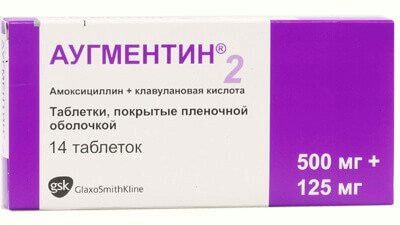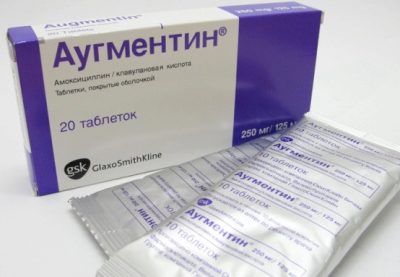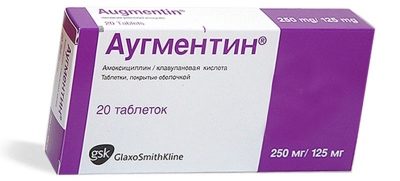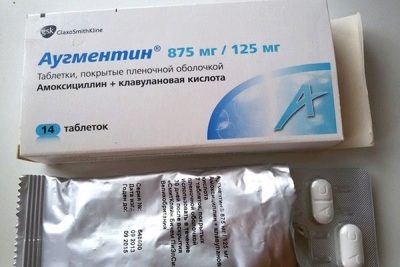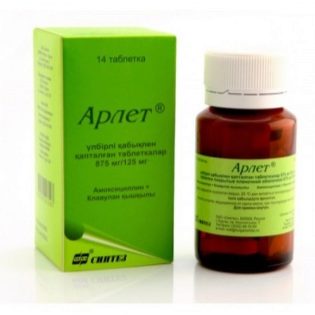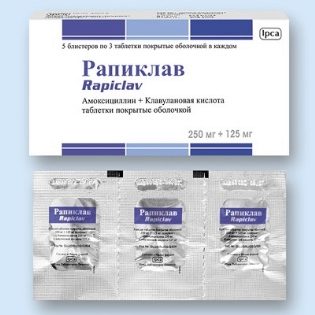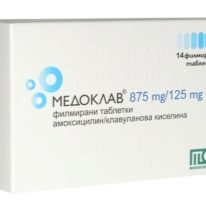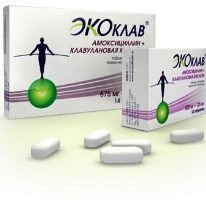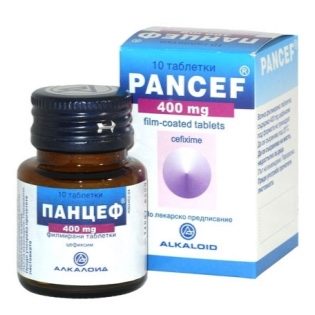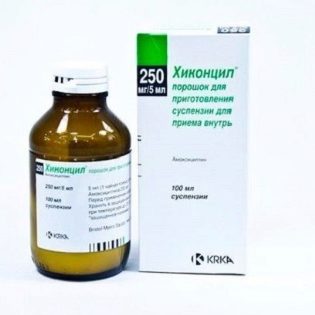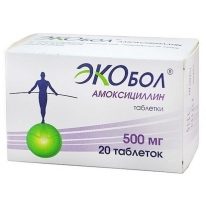Tablets "Augmentin" for children
When choosing an antibacterial agent for the child, they often prefer drugs that have a wide range of influence, for example, Augmentin. In childhood, it is usually used in suspensionbut this medicine is also represented by pills. Is it possible to give children this form of the drug and how to properly dispense such an antibiotic?
Release form
Augmentin tablets are distinguished by an oval shape, a white shell and a white or yellowish-white color at the break. One side of these tablets has a line along which the drug can be broken. On each side of the medication there are large letters A and C. Tablets are sold in blisters of 7 or 10 pieces, and one pack may contain 14 or 20 tablets.
The drug is available in other forms:
- Bottles with powder from which to prepare the suspension. This form is presented in several variants, depending on the dosage of amoxicillin on 5 milliliters of the drug - 125 mg, 200 mg, or 400 mg.
- Bottles with powder, which is diluted for intravenous injection. They are also available in two dosages - 500mg + 100mg and 1000mg + 200mg.
Composition
The active components of the Augmentin tablets are two compounds:
- Amoxicillin, which is represented in the drug by the form of trihydrate.
- Clavulanic acid, which is in tablets in the form of potassium salt.
Depending on the amount of these ingredients in one tablet, the following dosages are distinguished:
- 250 mg + 125 mg
- 500 mg + 125 mg
- 875 mg + 125 mg
In this designation, the first number indicates the amount of amoxicillin, and the second indicates the content of clavulanic acid.
Auxiliary components of the inner part of the tablets are colloidal silicon dioxide, MCC, magnesium stearate and sodium carboxymethyl starch. The casing of the medicine is made of macrogol (4000 and 6000), dimethicone, hypromellose (5 and 15 cps) and titanium dioxide.
Operating principle
Amoxicillin present in the composition of the drug has a bactericidal effect on various types of microbes, but it does not affect microorganisms capable of releasing beta-lactamase, since such enzymes destroy it. Thanks to the inactivating beta-lactamase clavulanic acid, the action spectrum of the tablets expands. For this reason, the combination of such active compounds is more effective than preparations containing only amoxicillin.
Augmentin is active against staphylococci, Listeria, gonococci, whooping cough sticks, peptokokk, streptococci, hemophilus bacilli, Helicobacter, clostridia, leptospir and many other microorganisms.
However, bacteria such as Proteus, Salmonella, Shigella, Escherichia, Pneumococcus, and Klebsiella can be resistant to this antibiotic. If the child is infected with viruses, mycoplasma, chlamydia, entero- or citrobacter, pseudomonad and some other microbes, the effect of Augmentin’s treatment will not be.
Indications
Augmentin tablets are discharged with:
- Sinusitis;
- Tonsillitis;
- Pneumonia or bronchitis;
- Purulent otitis;
- Pyelonephritis, cystitis and other infections of the excretory system;
- Whooping cough;
- Gonorrhea;
- Streptococcal / staphylococcal infection of the skin or soft tissues;
- Periodontitis and other odontogenic infections;
- Peritonitis;
- Infection of the joints;
- Osteomyelitis;
- Cholecystitis;
- Sepsis and other infections triggered by microorganisms susceptible to medication.
How old can you take?
The treatment with Augmentin tablets is recommended for children over 12 years old. It can also be prescribed for younger children, if the child’s body weight exceeds 40 kilograms. If it is required to give such a drug to a child with a lower body weight and at an earlier age (for example, at 6 years of age), use a suspension. Such a liquid form can be used even in infants.
Contraindications
Tablets do not give children who have a hypersensitivity to any of their ingredient. Also, the drug is contraindicated if the child is allergic to any other penicillin or cephalosporins antibiotics. If a small patient has an abnormal liver or kidney, the use of Augmentin requires monitoring by the doctor and adjusting the dosage depending on the test results.
We invite you to watch Dr. Komarovsky’s video on what medicines should be in the house where there is a child and how to take them correctly.
Side effects
The body of the child may respond to the reception Augmentina:
- The emergence of allergies, such as urticaria or pruritus.
- Liquid stools, nausea, or bouts of vomiting.
- Changing the number of blood cells, such as leukocytopenia and thrombocytopenia. In rare cases, the drug provokes anemia, agranulocytosis and other changes.
- The occurrence of candidiasis of the skin or mucous membranes.
- Increased liver enzymes.
- Dizziness or headaches.
Occasionally, treatment with such an antibiotic can provoke seizures, stomatitis, colitis, anaphylaxis, nervous agitation, inflammation of the kidneys and other negative reactions. If they appear in a child, the pills are immediately canceled.
Instructions for use
- The regimen of Augmentin tablets is affected by both the weight and age of the patient, the severity of the bacterial lesion, and the function of the kidneys.
- In order for the drug to cause fewer side effects from the gastrointestinal tract, it is advised to drink it during meals (at the beginning of the meal). If this is not possible, you can take a pill at any time, since digesting food does not affect its absorption.
- Medication prescribed for at least 5 days, but not longer than 2 weeks.
- It is important to know that one pill 500mg + 125mg cannot be replaced with two tablets 250mg + 125mg. Their dosages are not equivalent.
Dosing Table
Depending on the dose of the active compounds, the drug is prescribed to children over 12 years old:
| Dosage of amoxicillin and clavulanic acid | How to use |
| 250mg + 125mg | 1 tablet three times a day if the severity of the infection is mild or moderate |
| 500mg + 125mg | 1 tablet every 8 hours, that is, three times a day |
| 875mg + 125mg | 1 tablet with an interval of 12 hours, that is, twice a day |
Overdose
If you do not follow the recommendations for the use of Augmentin in an unnecessarily high dose, it adversely affects the gastrointestinal tract and can disrupt the water-salt balance in the children's body. The drug also provokes crystalluria, which is bad for the kidneys. With an overdose in children with renal insufficiency, convulsions are possible.
Interaction with other drugs
- If you give pills with laxatives or antacids, it will worsen Augmentin absorption.
- The drug is not recommended to be combined with bacteriostatic antibiotics, for example, with tetracycline drugs or macrolides. They have antagonistic effect.
- The drug is not used together with methotrexate (its toxicity increases) or allopurinol (the risk of skin allergy increases).
- If you give along with this antibiotic indirect anticoagulants, their therapeutic effect increases.
Terms of sale
To buy Augmentin in a pharmacy, you need to consult a doctor and get a prescription from him. The price of tablets depends on their dosage and quantity in the package.It varies from 230 to 380 rubles.
Storage features
Keep at home a solid form Augmentina advise at a temperature not higher than + 250C. A dry place in which the drug cannot reach a small child is best suited for storing medication. The shelf life of tablets 500mg + 125mg is 3 years, and the drug with other dosages is 2 years.
Reviews
In most cases, parents respond well to the use of Augmentin in children, noting that such a drug acts fairly quickly and fights bacterial infection very effectively. Judging by the reviews, adverse symptoms appear when taking it rarely. Among them, the most frequently noted negative reaction of the digestive tract.
Analogs
To replace the Augmentin solid form, other agents with the same composition of active substances can be used, for example:
- Amoxiclav.
- Ecoclav.
- Rapiklav.
- Medoclav
- Panklav
- Arlet
- Flemoklav Solyutab.
- Panklav 2X.
- Rankavl.
- Amoxiclav Quiktab.
Almost all of these medicines are presented in pill form, but some are produced in suspension. In addition, Augmentin’s substitute may be another penicillin antibiotic or cephalosporin (Suprax, Amosin, Pancef, Ecobol, Hikontsil). However, it is necessary to select such an analogue together with the doctor, as well as after analyzing the sensitivity of the pathogen.

